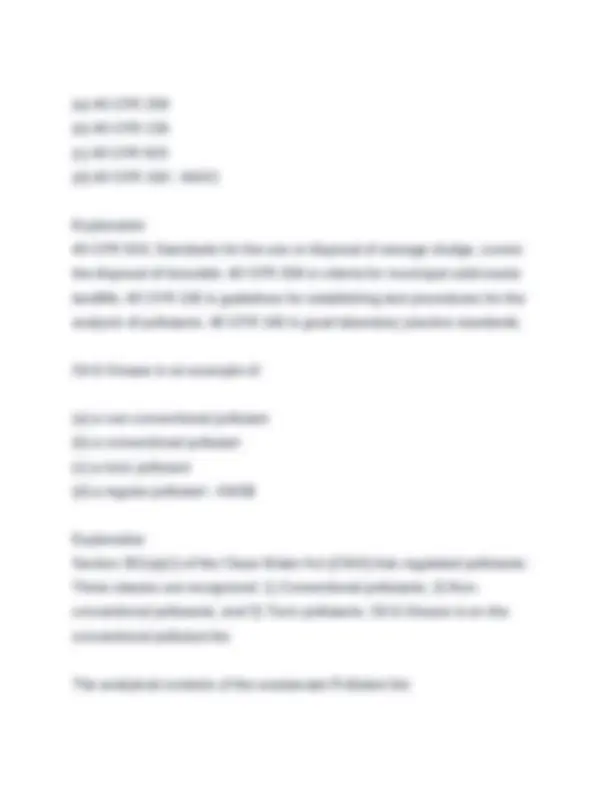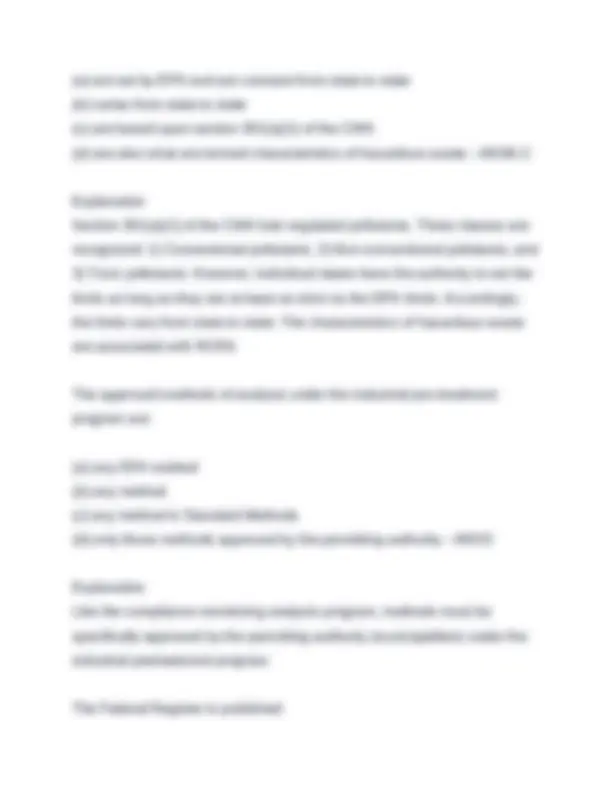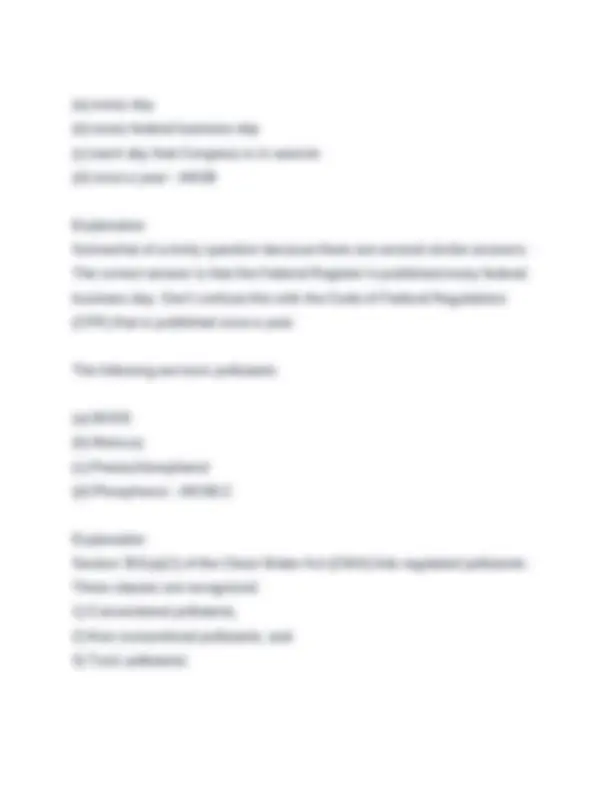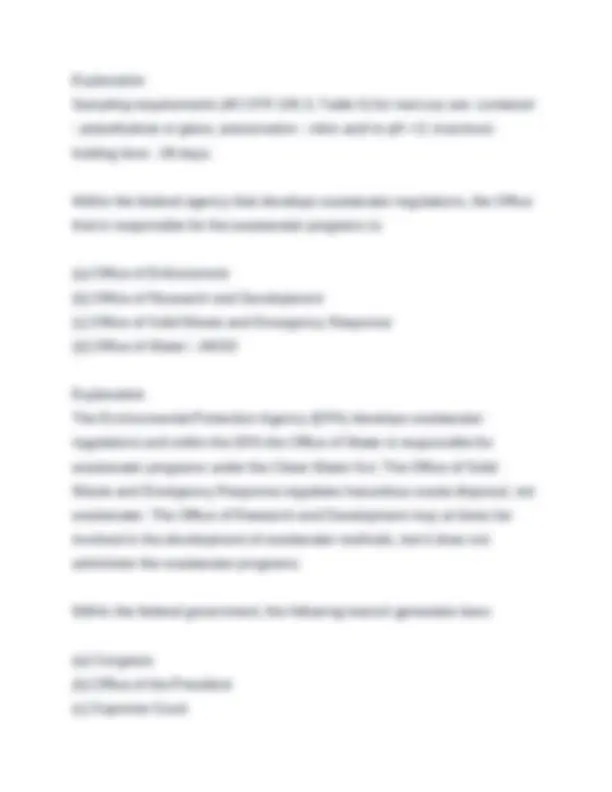







Study with the several resources on Docsity

Earn points by helping other students or get them with a premium plan


Prepare for your exams
Study with the several resources on Docsity

Earn points to download
Earn points by helping other students or get them with a premium plan
Community
Ask the community for help and clear up your study doubts
Discover the best universities in your country according to Docsity users
Free resources
Download our free guides on studying techniques, anxiety management strategies, and thesis advice from Docsity tutors
Wastewater Laboratory Analyst Certification Exam Practice Questions with Correct Answers 2025-2026. Graded A
Typology: Exams
1 / 9

This page cannot be seen from the preview
Don't miss anything!






40 CFR 434 contains: (a) the NPDES permit for the copper mining industrial group (b) air emission standards for the petroleum refining industrial group (c) effluent pre-treatment standards for the coal mining industrial group (d) stormwater run-off standards for the pharmaceutical industrial group - ANSC Explanation 40 CFR 434, coal mining point source category covers effluent pre- treatment standards for the coal mining industrial group. There is no general NPDES permit for the copper mining industrial group. There is no pre-treatment effluent standards specifically for the copper mining industrial group, although possibly applicable standards for mineral mining (40 CFR
(b) EPA 608 (c) SM 6630 B & C (d) ASTM D3086-90 - ANSB,C,D Explanation Heptachlor, a pesticide, is a target analyte of EPA method 608 (organochlorine pesticides by GC-ECD), SM 6630 B&C (Standard Methods organochlorine pesticides by liquid-liquid extraction GC method I and liquid- liquid extraction GC method II), and ASTM D3086-90. Heptachlor is a target analyte for EPA method 8081, but this method is part of SW-846. Methods in SW-846 are not identified as approved methods for analysis of wastewater in 40 CFR 136. Compliance monitoring analysis of wastewater: (a) can be performed by any method (b) can be performed by any method in Standard Methods (c) can be performed by any method in the 18th Edition of Standard Methods (d) can be performed by any method listed in 40 CFR 136 - ANSD Explanation The Clean Water Act specifically authorizes the EPA Administrator to identify testing procedures that are appropriate for monitoring wastewater. These identified methods are listed in 40 CFR 136. Disposal of biosolids is covered under:
(a) are set by EPA and are constant from state to state (b) varies from state to state (c) are based upon section 301(a)(1) of the CWA (d) are also what are termed characteristics of hazardous waste - ANSB,C Explanation Section 301(a)(1) of the CWA lists regulated pollutants. Three classes are recognized: 1) Conventional pollutants, 2) Non-conventional pollutants, and
(a) every day (b) every federal business day (c) each day that Congress is in session (d) once a year - ANSB Explanation Somewhat of a tricky question because there are several similar answers. The correct answer is that the Federal Register is published every federal business day. Don't confuse this with the Code of Federal Regulations (CFR) that is published once a year. The following are toxic pollutants: (a) BOD (b) Mercury (c) Pentachlorophenol (d) Phosphorus - ANSB,C Explanation Section 301(a)(1) of the Clean Water Act (CWA) lists regulated pollutants. Three classes are recognized:
The correct answer is the Clean Water Act. The Safe Drinking Water Act covers drinking water, while the Resource Conservation and Recovery Act covers hazardous waste disposal. The Federal Water Pollution Control Act is a precursor to the Clean Water Act and has been superseded. The legal responsibility for insuring that the approved methods of analysis have been used to generate data lies with: (a) the laboratory (b) the EPA (c) the person who signs the DMR (d) the state agency issuing the permit - ANSC Explanation The ultimate responsibility for determining that the correct methods have been used and referenced lies with the person who signs the Discharge Monitoring Report (DMR). The signature is attestation that the signer takes all responsibility. The proper collection and preservation for samples collected for mercury analysis is: (a) collect in a Mason® jar and send to the lab (b) collect in a pre-cleaned glass or polyethylene container (c) add acid (d) add nitric acid to pH <2 - ANSB,D
Explanation Sampling requirements (40 CFR 136.3, Table II) for mercury are: container